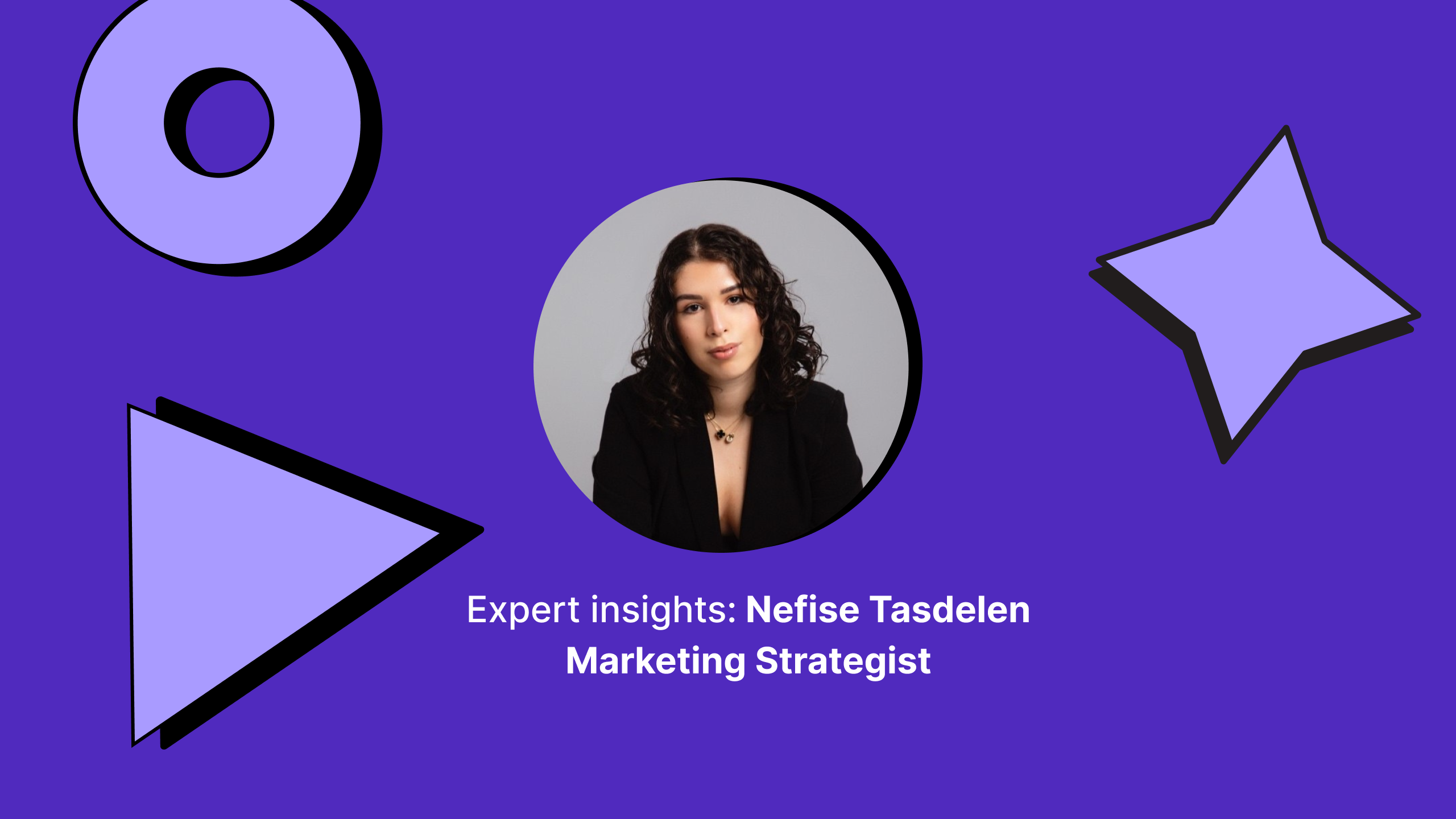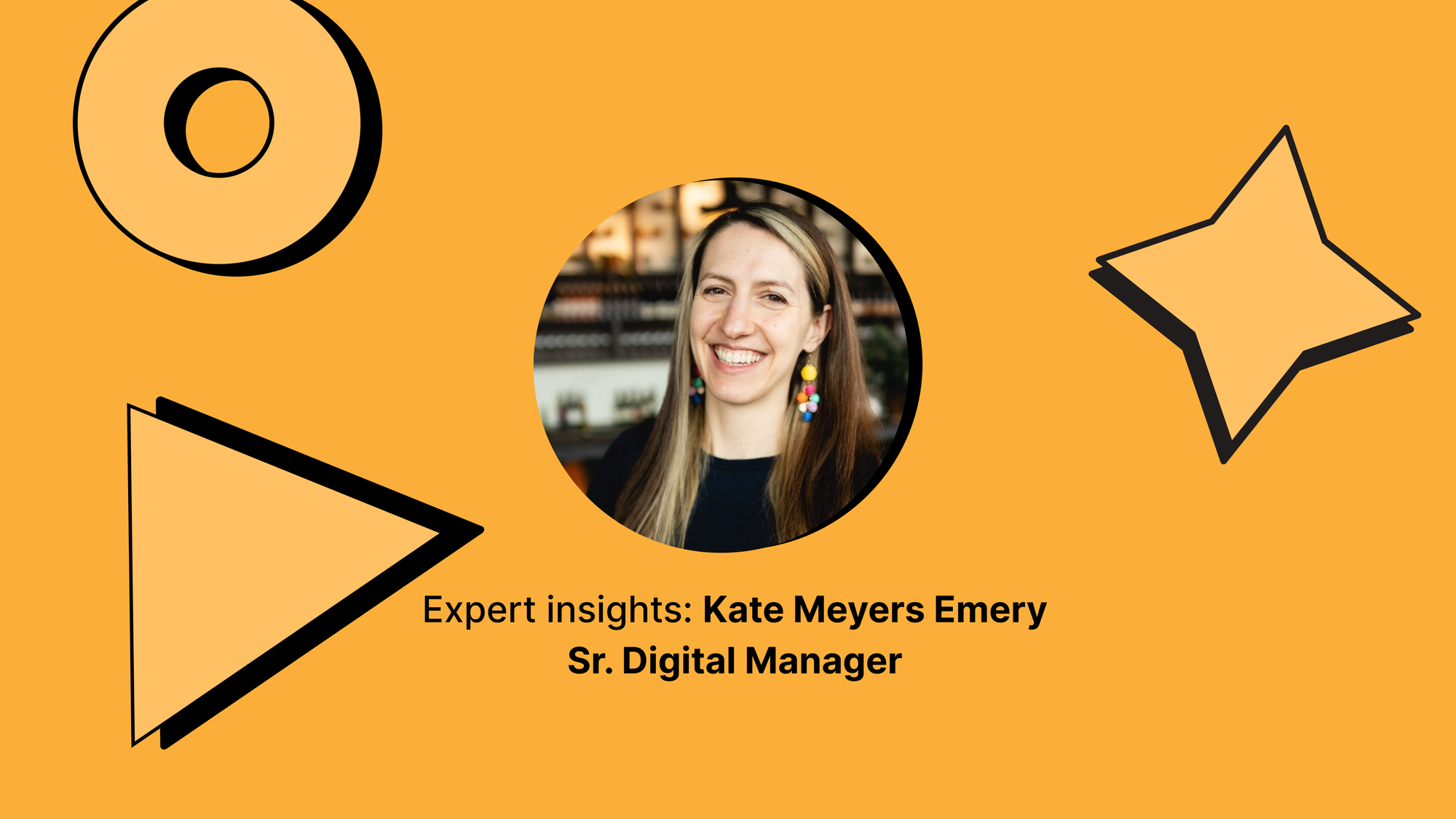Impact of Social Media on Business: Benefits and Risks
Understand the full impact of social media on business. Find out how brands attract customers, refine products, improve support, and grow faster with the right social strategies.
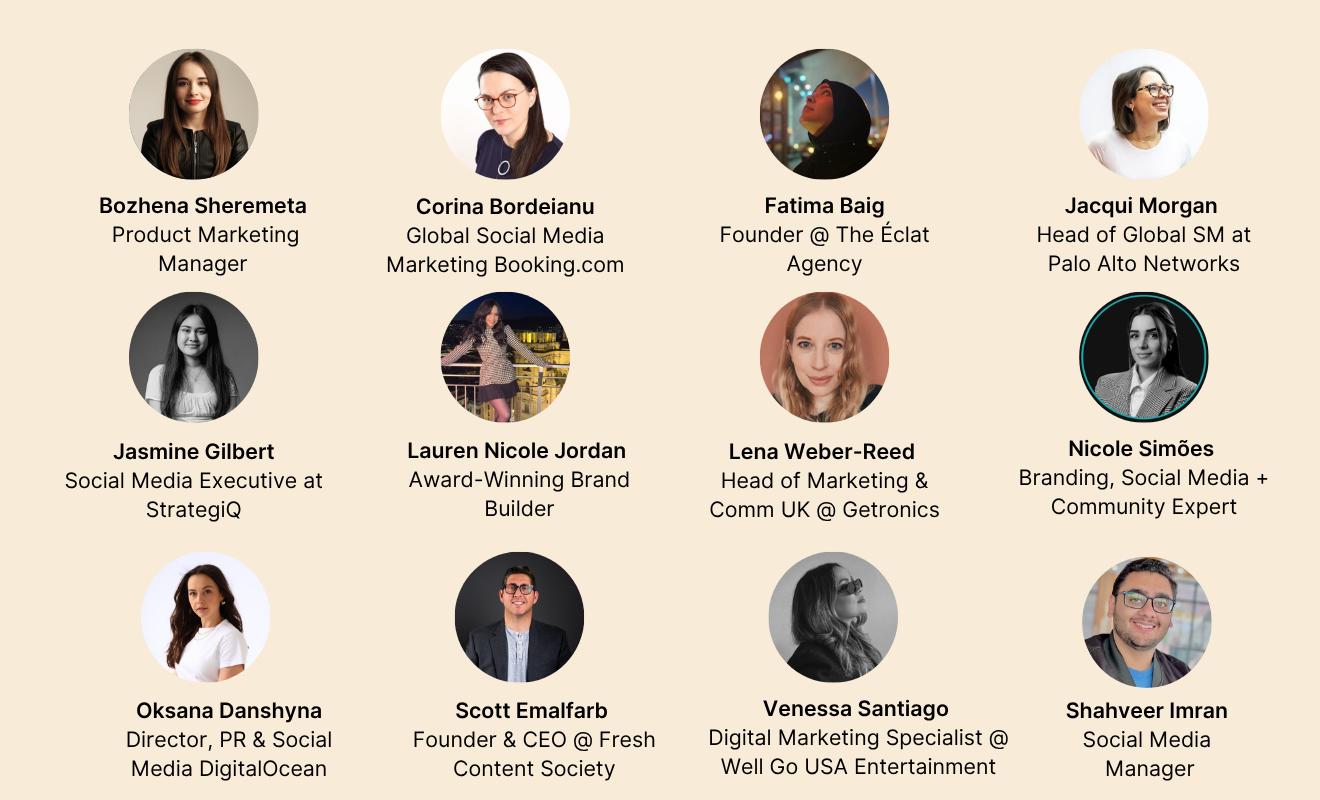
Dollar Shave Club showed the world what happens when social media gives the underdog a microphone. With a video that cost just $4,500, they pulled in 12,000 orders in 48 hours and eventually sold the company for a billion dollars.
I still think about that anytime someone says social doesn’t drive real results.
I’ve seen brands grow online faster than they ever could offline because social rewards bold ideas. One smart post can shift perception. One great story can pull people in.
In this guide, we’ll go through 12 ways social media is impacting businesses, along with real-life examples and best practices you can incorporate.
Key takeaways
-
Revenue & growth: Social media doesn’t just support sales anymore—it actively helps people discover, trust, and buy products in one place.
-
Brand authority & trust: When brands consistently share useful ideas and real stories, social media becomes where trust is built long before a purchase happens.
-
Community & retention: People stay loyal to brands on social media because they feel part of something, not because they’re constantly being sold to.
-
Market intelligence & insights: Every comment, DM, and reaction on social media quietly tells you what your audience wants and what your competitors are missing.
-
Customer experience & support: Fast, honest replies on social media can turn everyday problems into moments that actually strengthen customer relationships.
-
Talent & employer brand: Showing real people behind the brand on social media makes your company more relatable—and far more attractive to future hires.
12 ways social media impacts businesses
Social media impact on business happens in every part of their growth journey. Let’s go through each.
1. Boosts revenue through social commerce
About 50% of shoppers made a purchase through social media. Not only that, social commerce made up 19% of global ecommerce sales in 2024.
Those aren’t small numbers. They show a clear shift in how people shop. Social platforms aren’t just places to talk about products anymore. They’re where buying decisions happen and where purchases increasingly take place.
With in-app shopping, creator storefronts, and seamless checkout, social platforms now act as full sales engines.
For example, here’s how Fabletics has an Instagram storefront where customers can browse products, add them to the cart, and purchase them directly within the app.
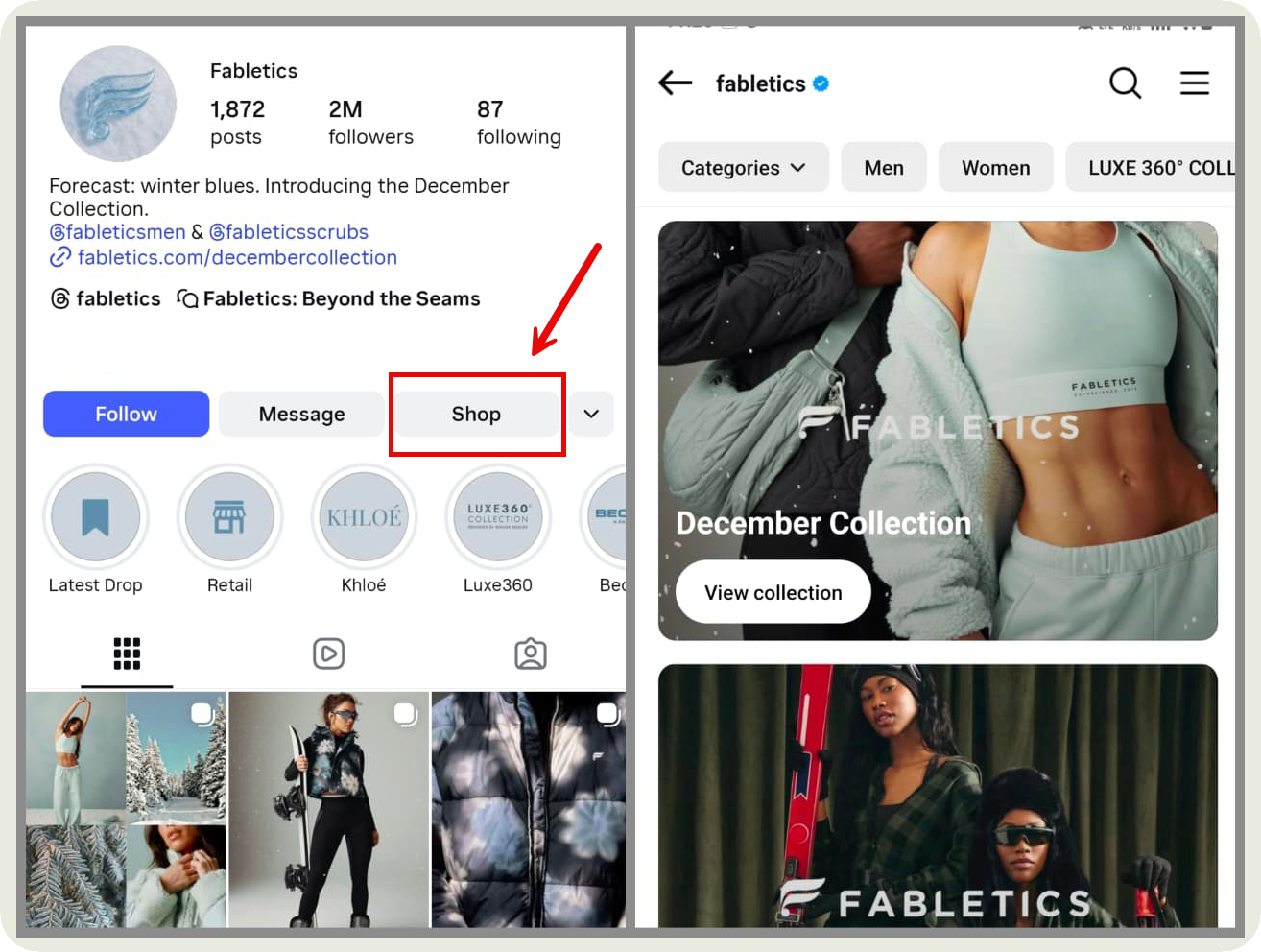
The story of Manny's Deli, shared by Scott Emalfarb, Founder and CEO of Fresh Content Society, further illustrates how social media affects business and drives sales.
“When the pandemic hit, physical customer interactions were no longer possible. Yet, with a heartfelt social media post, Manny's Deli was able to rally its online community. With just one post fueled by sincerity, FCS managed to increase sales up to 1,500% that was sustained for 90+ days, with over 10M impressions, 500,000+ engagements across all channels and media pickup, including CNN, ABC7 Chicago, NPR and many more. We had customers calling from all over the world to buy, ship and support from seeing our social media post!” - Scott Emalfarb, Founder and CEO, Fresh Content Society
Best practices to boost revenue through social commerce
- Make your posts shoppable. Add product tags to photos, videos, and Reels so people can buy without leaving the app. Aim to tag products in at least a third of your content.
- Use real customer videos to sell. Share short try-on clips, unboxings, or reviews. These convert better than polished ads because people trust real experiences.
- Create small, limited-time offers. Flash sales, follower-only discounts, or early access drops prompt people to make purchases quickly. Promote these using Stories and pinned posts.
- Reduce buying steps. Make sure your checkout process is clean, fast, and mobile-friendly. The fewer steps people take, the higher the conversion.
2. Improves brand awareness and positions you as a thought leader
Imagine being the brand people look up to in your niche. That is what strong social presence does.
When you consistently break down trends, explain complex ideas simply, or join cultural conversations with smart takes, your audience starts treating you as the go-to source.
One brand that has mastered this impact of social media on marketing is HubSpot. Their bite-sized marketing lessons on LinkedIn and Instagram built a fan base of marketers who follow them long before they ever sign up for anything.
Here’s a recent example.
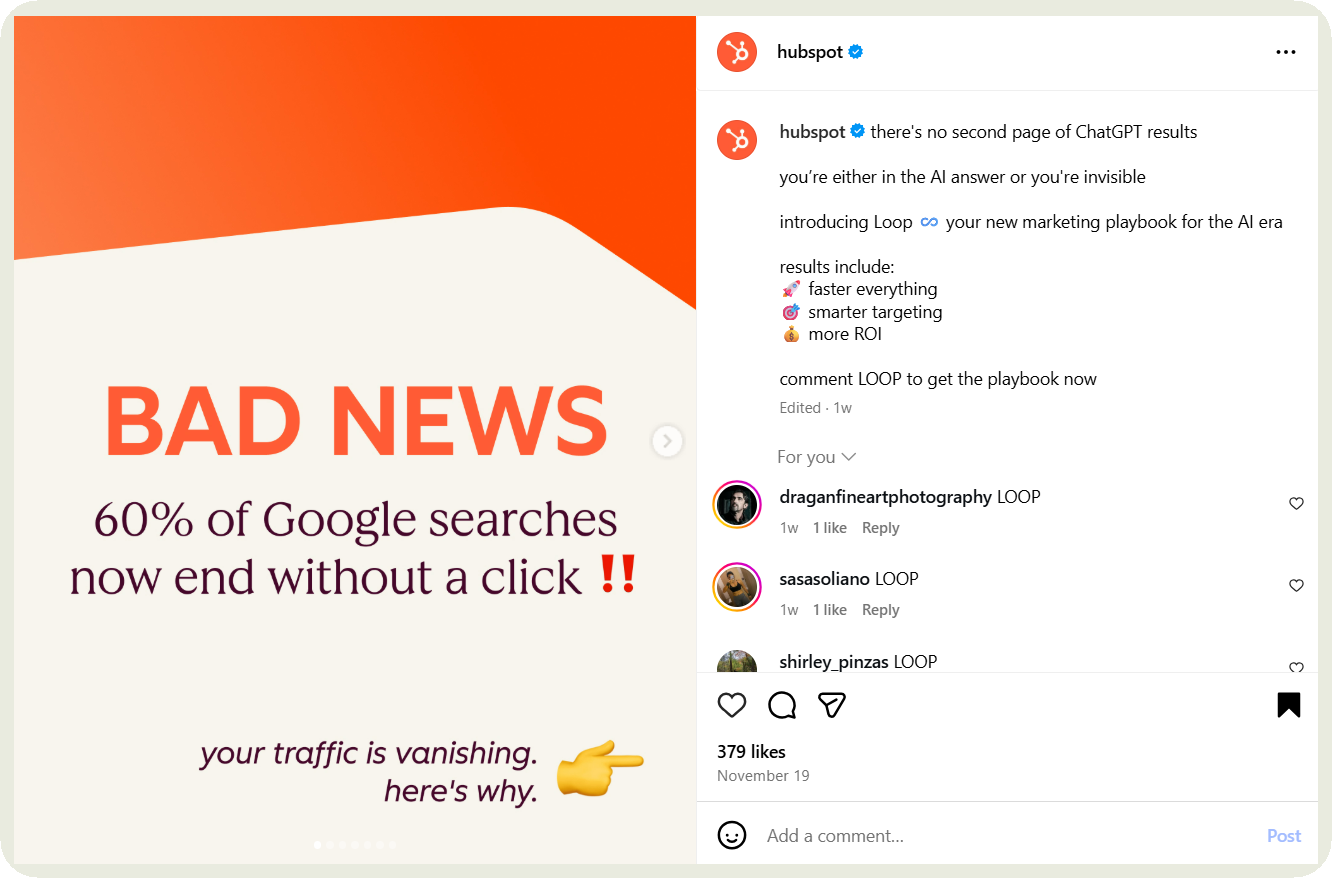
Fatima Baig, founder of The Éclat Agency, shared with us how a modest social media campaign for a new chocolate launch exceeded expectations, impacting sales and driving brand visibility and long-term customer engagement.
She said that a mix of organic and paid social media strategies resulted in a 50% increase in boutique foot traffic, a 34% boost in web sales (even for unrelated products), and 2.2K new followers within just two weeks.
The campaign's success continued to show during the holiday season, when the products sold out even before promotions began. She said —
“Social media has ripple effects far beyond your initial goals, impacting various areas of your business. In my experience, it does more than meet your immediate goals; it creates lasting, compounding effects across your entire business.”
Best practices to improve brand awareness and position you as a thought leader
- Give your opinion on things that happen in your niche. React to industry news, trends, and shifts in real time. Short, sharp opinion posts build authority faster.
- Teach something often. Share frameworks, checklists, how-tos, and breakdowns your audience can use the same day. People remember the accounts that help them do their job better.
- Use content formats that spark saves and shares. Carousels, short explainers, and contrasting before-and-after examples naturally boost visibility.
- Collaborate with other experts. Interviews, joint lives, comment exchanges, or co-created posts expose you to new audiences and transfer credibility.
- Create series-based content. Weekly insights, recurring themes, or named content pillars keep your brand top of mind and make you easier to follow for expertise, not just one-off posts.
3. Fosters community-building and retention
Have you ever followed a brand simply because you love being in their community? Sure, the product might be great, but that is not what keeps you around. You stay because they make you feel connected to something bigger than a transaction. They make you feel like you belong.
That’s the power of social media in business.
It helps you create a space for people to interact, share stories, ask questions, and build relationships. For example, we do the same with our Socialinsider community on Facebook.

Kendall Dickieson's work with Graza, for example, highlights how the strategic use of organic social media and partnerships with influencers like Molly Baz helped build a passionate community even before the brand launched, leading to sold-out products and partnerships with major retailers like Whole Foods.
“Social can unlock IRL opportunities for a brand where that retail channel is important by proving the validity of your product via influencers, content (via engagement), and more. When it comes to sales, you can also turn your best community members, like we have, into ambassadors of your brand.” - Kendall Dickieson, Founder, Flexible Creative
When it comes to community building, Nike is a great example. They have several communities like Nike Run Club and Training Club where users share progress, join challenges, and connect over fitness goals.
For example, they have separate accounts for these clubs and a channel where users share updates. Here’s a glimpse of it.
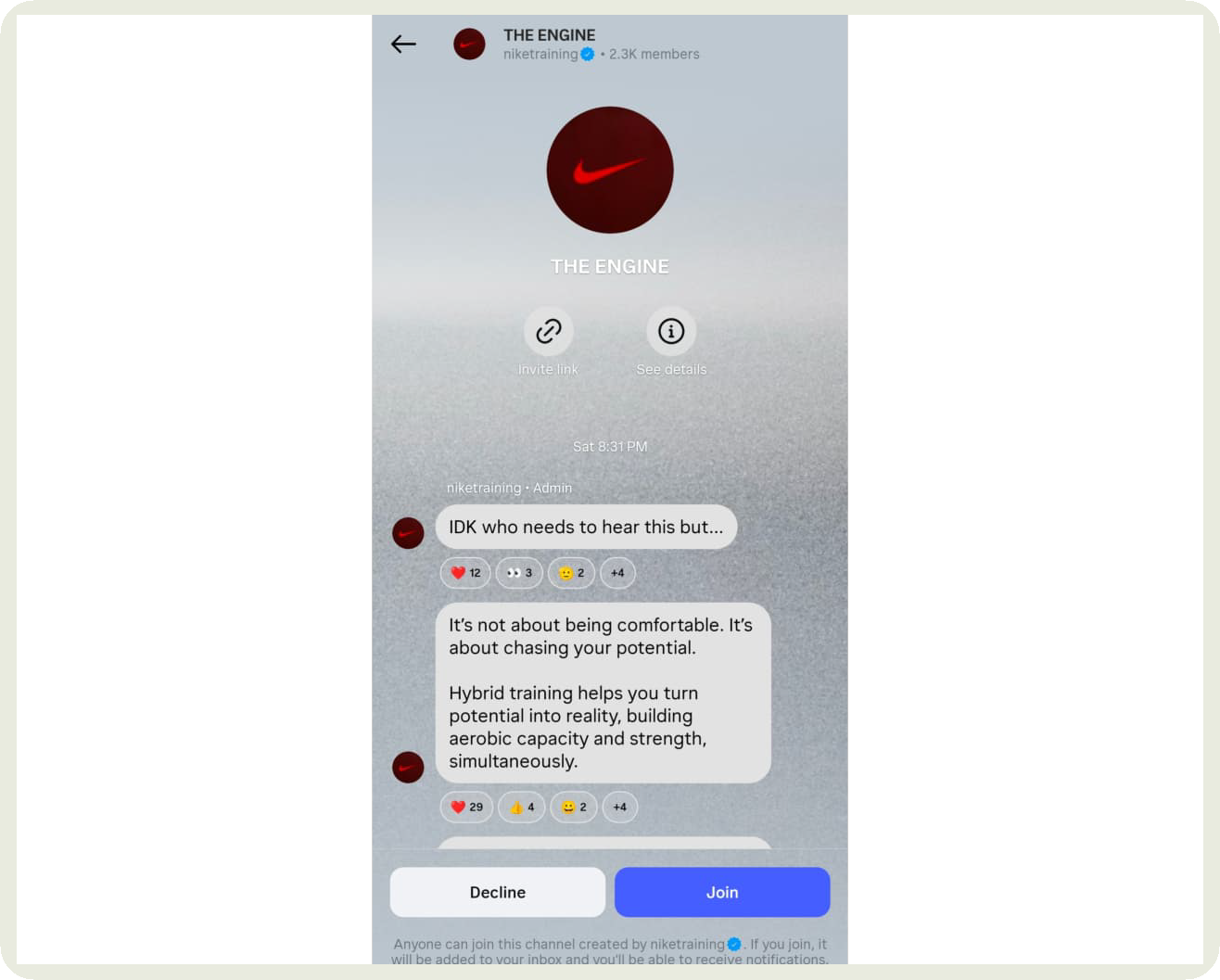
The best thing is that users can turn workouts into a social experience and stay connected to Nike.
Best practices to foster community building and retention
- Create a dedicated community hub. Whether it is a Facebook Group, Discord server, or a private Instagram channel, give people a space to talk to each other, not just to you. Seed it with prompts, questions, and helpful resources.
- Spotlight your community often. Share user stories, achievements, photos, or behind-the-scenes contributions. People stay loyal when they feel seen. Make ‘community-first content’ a recurring format.
- Build rituals and recurring touchpoints. Weekly challenges, monthly AMAs, insider-only drops, or themed conversation days give people a reason to show up regularly and stay engaged.
- Turn your power users into ambassadors. Identify your most active followers and give them early access, referral perks, or co-creation opportunities. When people help shape the brand, they stick with it longer.
- Co-create content with your audience. Ask for ideas, let them vote on upcoming features, or invite them to participate in campaigns. Ownership builds retention.
4. Create hype around your products and services
It’s five days before your most crucial product update release. You join your hands and pray that it wows your customer or at least doesn’t get ignored.
Turns out, social media can help you create hype before the update even releases. Think of teasers that spark curiosity. Countdowns that build tension. Creator collaborations that expand your reach.
This can lead to waitlists, sellouts, and viral conversations that push your product far beyond your current followers.
Apple is one brand that does this extremely well. It uses sleek teaser videos and intentionally cryptic posts to spark speculation before new product announcements. Social conversations spike weeks before launch, creating global anticipation without a single paid promo.
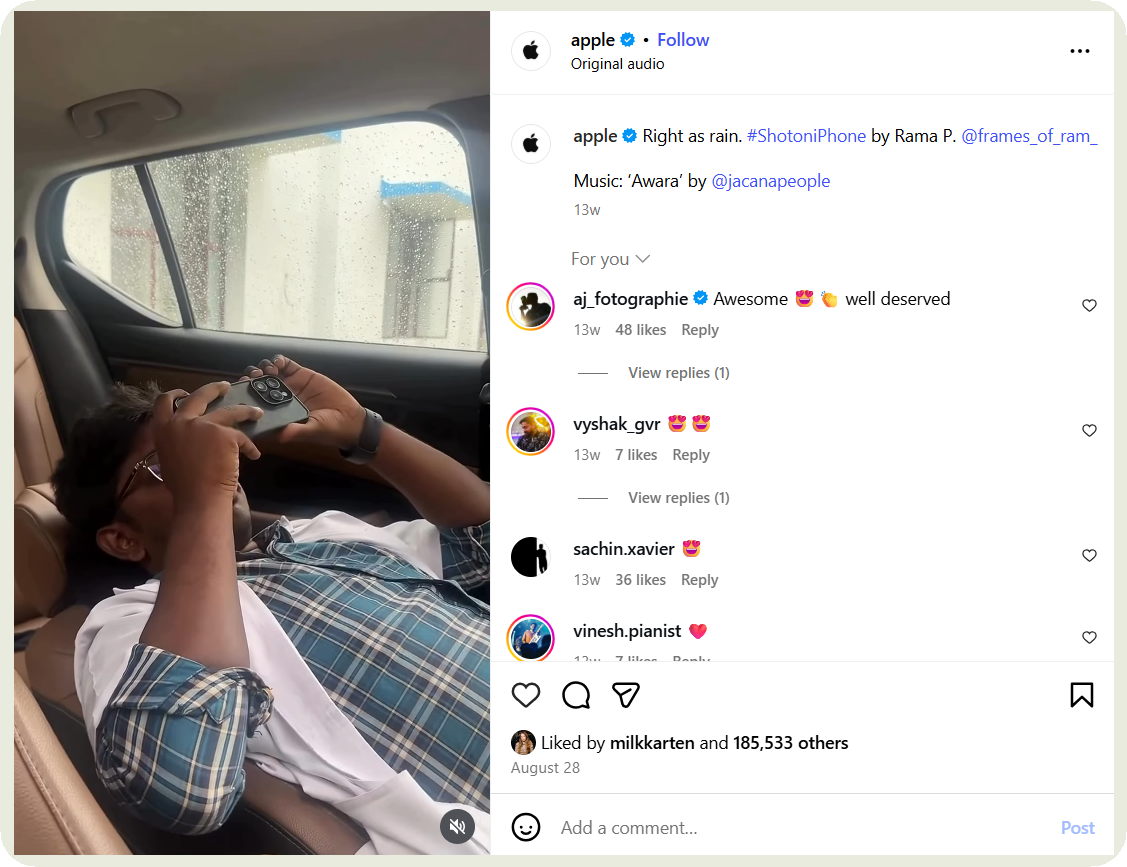
Another powerful example of social media's influence comes from Sheeza Anjum, Social Media Strategist at Havas People, who highlights KFC's innovative approach to launching a new product by leaning into customer feedback —
KFC used criticism about their old fries as a way to introduce a new recipe on Twitter. This bold strategy gained the brand an impressive 66,000 new customers, proving that social media can turn even negative sentiment into an opportunity for growth.
Best practices to create hype around your products and services
- Build a pre-launch content arc. Don’t drop everything at once. Roll out teasers, hints, and partial reveals over a few days or weeks. Let curiosity compound.
- Use countdowns and milestone posts. Create a sense of urgency with daily or weekly countdowns, “3 days to go” posts, or sneak peeks tied to specific dates.
- Co-create with influencers and loyal customers. Give early access to creators or power users. Let them share first impressions. Their excitement becomes social proof.
- Turn feedback into fuel. Just like KFC, reframe criticism or customer suggestions as part of the story. ‘You asked. We listened’ is one of the most powerful hype builders.
- Engage heavily during the hype window. Respond to comments, reply to speculation, and amplify UGC. Momentum grows when the brand participates in the conversation.
5. Builds trust through earned proof
Think about the last time you bought something because a real person swore it changed their life. That is earned proof at work. Social media takes this human instinct and multiplies it. People trust unfiltered customer posts, quick reviews, and creator shoutouts far more than any polished brand claim.
When someone shares a before and after, records an honest unboxing, or casually mentions your product in their daily routine, it feels real. And that credibility travels fast.
I strong believe that your happiest customers can become your strongest sales engine and social media for businesses helps further that cause.
For example, GoPro is practically powered by earned proof. Scroll through their feed and you will see a stream of jaw-dropping user videos from surfers, hikers, and creators who are obsessed with showing what the camera can do.
GoPro rarely needs to talk about its features. Real customers do it for them, and their content is more convincing than any ad the brand could produce.
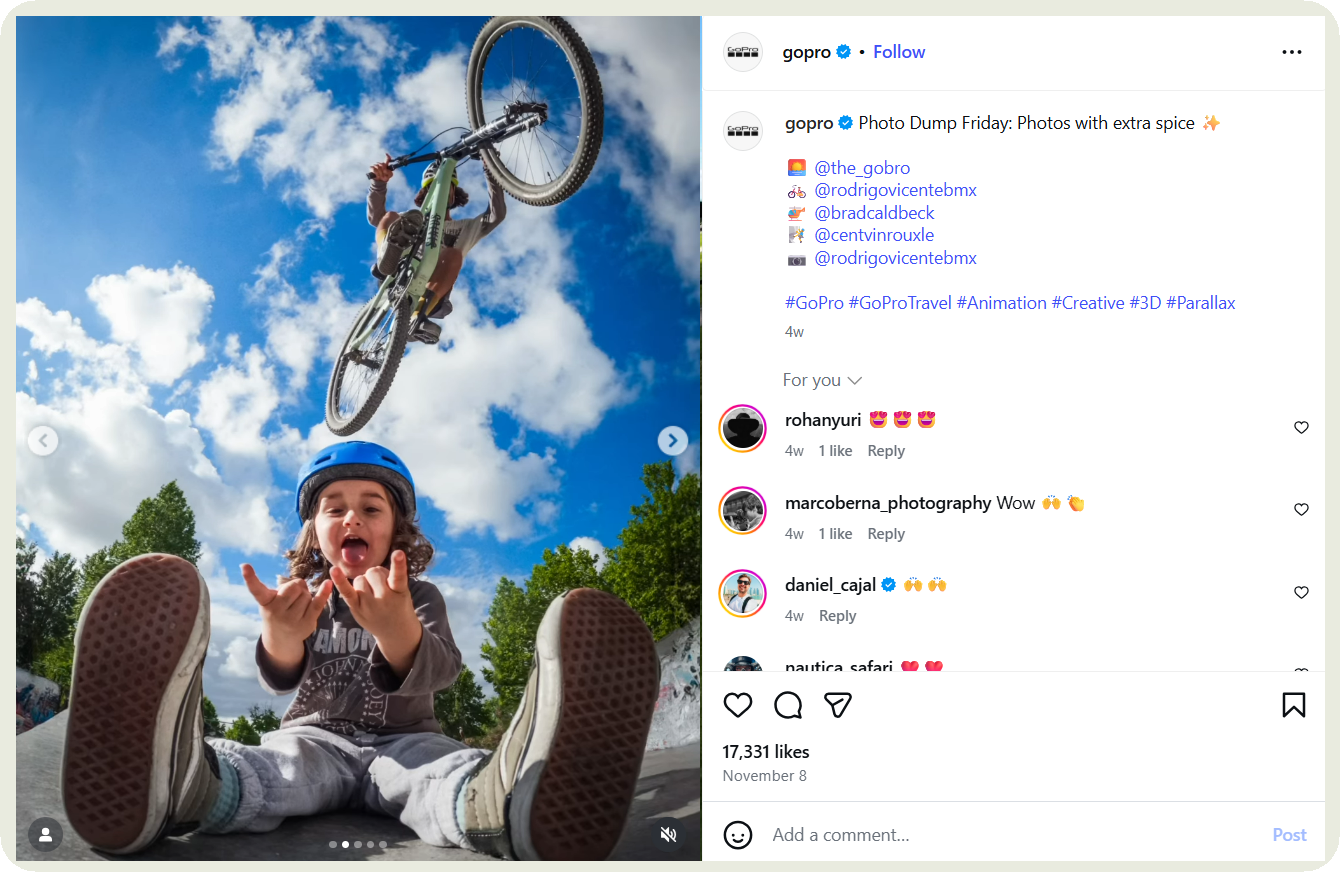
Best practices to build trust through earned proof
- Feature real customers often. Regularly repost UGC, reviews, and everyday use cases. Make it obvious that real people love your product.
- Create prompts that encourage sharing. Ask users to share before and afters, unboxings, or product stories using a branded hashtag. Lowering the barrier increases participation.
- Highlight creators who use your product naturally. Partner with influencers who already love your brand. Their genuine enthusiasm reads far more trustworthy than scripted endorsements.
- Respond publicly to feedback. Address questions, acknowledge criticism, and showcase improvements. Openness reinforces credibility.
- Build a dedicated UGC hub. Create a playlist, story highlight, or landing page where new visitors can see real proof at a glance.
6. Enhances employee branding
Whenever I’m checking out a company online, I always end up trusting the employees more than the brand account.
If someone on the team shares a win, a behind-the-scenes moment, or even a funny slice of their workday, I immediately get a sense of what it actually feels like to work there. And honestly, it tells me more about the culture than any polished ‘We’re hiring’ page ever could.
One company that I love for this is Adobe. They use its ‘Adobe Life’ Instagram to highlight employee stories, passion projects, and team culture.
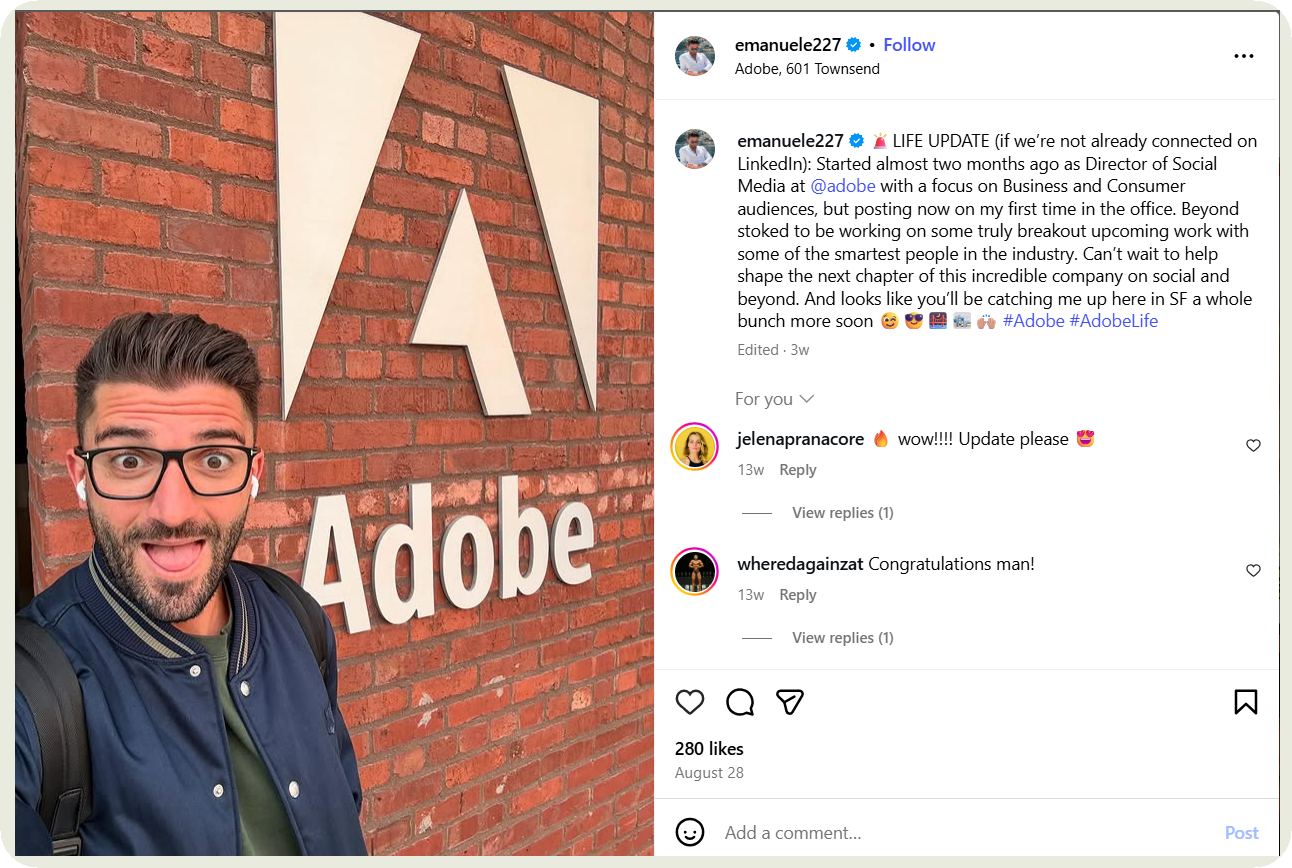
No doubt the company consistently ranks as a top place to work.
Bozhena Sheremeta, Product Marketing Manager at Embrace Software for Educators, shares how empowering employees to contribute to social media content can significantly enhance brand perception and recruitment efforts.
At one of her former B2B clients, the company's social media strategy initially centered around sharing standard corporate updates. However, after introducing authentic employee-driven content, including videos where team members shared professional insights, the impact on both engagement and brand visibility was substantial.
“Before the experiment, their posts averaged 200-300 impressions. However, within a few months, the average reach soared to over 1,000 impressions per post, while engagement rates increased from 5-7% to over 10%, mostly coming from people's comments and clicks.”
Additionally, she highlights how involving employees as content creators organically improved the company's HR efforts. Without any paid job ads, they saw an influx of job candidates.
“Turning employees into brand ambassadors turned out to be more engaging than emails and much more cost-effective than paid social.”
Best practices to enhance employee branding
- Spotlight your team regularly. Feature employee stories, career journeys, passion projects, and day-in-the-life content on your brand channels.
- Make it easy for employees to participate. Provide templates, prompts, and assets they can adapt. The easier it is, the more people contribute.
- Turn employees into expert voices. Encourage them to share industry insights, learnings, and thought leadership. This strengthens both personal credibility and employer reputation.
- Engage with employee posts. Like, comment, and reshare team content from brand accounts. It reinforces their effort and boosts reach.
- Leverage employee-driven content in hiring. Add UGC-style clips, quotes, or snippets from team members to job posts or career pages. It makes your employer brand feel alive and relatable.
7. Fuels competitor research and understanding
I treat social media like a real-time radar for what my competitors are doing. I can instantly see their new product teasers, how they position themselves, which creators they suddenly start working with, and even the comments their audience complains about.
I don’t need reports or intel. It is all right there in the feed.
To make competitor analysis easier, I use the Benchmarks feature in Socialinsider. I add competitor profiles and get a side-by-side comparison of social media metrics.
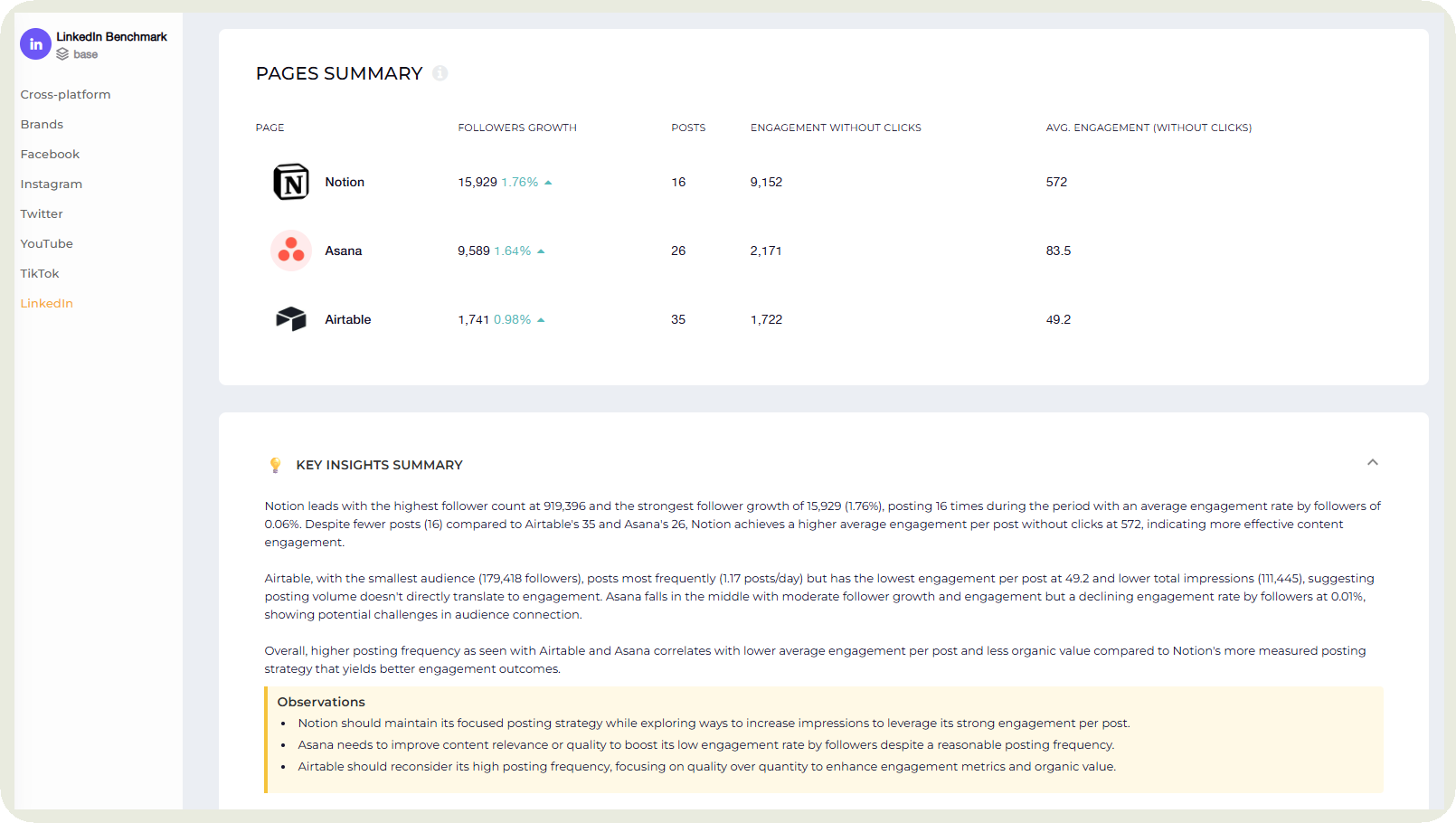
Not only that, I can go to their individual profiles and check their content performance and pillars.
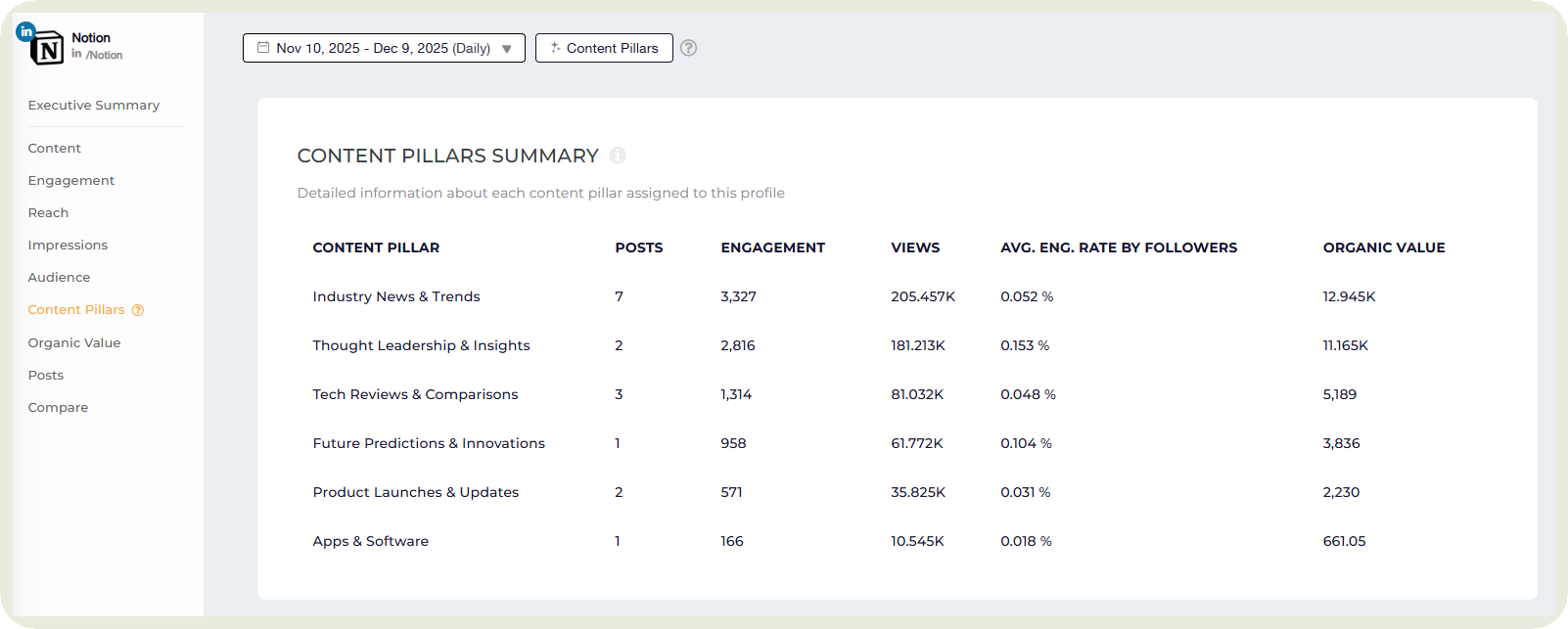
This helps me move faster. I can adjust my messaging, double down on gaps they are missing, and avoid copying strategies that clearly flop for them.
Corina Bordeianu, Senior Social Media Manager at Booking.com, highlights the importance of competitor research and staying attuned to emerging trends, particularly on platforms like TikTok.
“By benchmarking against competitors, we ensure our content not only stands out but also drives stronger engagement and positive brand sentiment.”
Best practices to fuel competitor research and understanding
- Track competitors consistently, not occasionally. Set a weekly or biweekly routine to check their content, engagement spikes, creator partnerships, and messaging shifts. Patterns matter more than one-off posts.
- Study their comment sections. Customer complaints, repeated questions, and sentiment swings reveal gaps you can fill and mistakes you can avoid.
- Watch their paid strategies. Track recurring ad angles, creative hooks, and landing pages. If an angle stays live for weeks, it is likely performing.
- Map their partnerships. Notice which creators, brands, or ambassadors they collaborate with. You can spot audience interests and partnership opportunities they may be missing.
- Track reactions to their launches. Monitor how people respond to new features, updates, or campaigns. This gives you insight into audience expectations before you launch something similar.
8. Drive website traffic through social
Social media is one of the fastest ways to pull people from ‘scrolling mode’ into ‘I want to learn more' mode. It meets your audience where they already are, grabs their attention with something they care about, and nudges them straight to your site with real intent.
When a post answers a question they’ve been thinking about, sparks curiosity they have to satisfy, or teases value they can only get on your website, the click becomes the obvious next step.
Best practices to drive website traffic through social
- Create content that ‘opens a loop.’ Share part of a framework, a teaser of data, or a short insight that feels incomplete. People click to close the loop.
- Use strong, specific CTAs. Instead of ‘Read more,’ guide intent with lines like ‘See the full breakdown,’ ‘Get the full template,' or ‘Explore the case study.’
- Repurpose blog posts into scroll-stopping formats. Turn articles into carousels, short videos, infographics, or quote cards. Each piece pushes users toward the full content.
- Make landing pages match the promise. Ensure the page you send people to immediately delivers on the value teased in the post. Mismatches kill trust and future clicks.
- Leverage UTM links for clarity. Track which platforms, formats, and posts actually drive high-intent traffic so you can double down on what works.
9. Aids in recruiting
Social media has quietly become one of the most efficient job boards you can use. Instead of relying only on traditional listings, you can put openings directly in front of the people who already follow your brand, like your content, and understand your mission.
You can share job posts as engaging visuals, short videos, carousel breakdowns of the role, or even behind-the-scenes clips about what the team actually does.
Platforms like LinkedIn, Instagram, and TikTok make it incredibly easy to spread the word fast.
And because people see your culture, work style, and values alongside the job listing, you attract applicants who already feel connected to what you do.
Shahveer Imran, Social Media Marketing Specialist with North American Staffing Services, has witnessed firsthand how platforms like LinkedIn and Meta have become essential tools in modern recruitment —
“Take LinkedIn as an example. In our experience, we've seen a 300% increase in candidate outreach response rates simply by optimizing how we present job roles through targeted posts and relevant hashtags. LinkedIn's ability to leverage data like industry, job function, and skill set lets us narrow down a pool of candidates that fit the exact criteria our clients are seeking. We've even managed to fill urgent positions within 48 hours through paid campaigns that boost visibility to qualified candidates.”
Best practices to aid in recruiting
- Highlight the ‘why.’ Show candidates why the role matters, what impact they’ll make, and what growth looks like.
- Leverage employee networks. Encourage team members to repost openings with their own context or experiences. Their credibility boosts reach and trust instantly.
- Use targeted hashtags and keywords. Help your roles surface in searches by adding function, industry, and skill-specific tags. This improves visibility with the right audience.
- Run paid boosts for important roles. Promote openings to specific locations, industries, or skill sets. As Shahveer’s team found, smart paid targeting can drastically cut hiring time.
- Make the application experience frictionless. Link directly to the job page, ensure mobile-friendly applications, and keep forms short. If applying feels painful, people drop off.
10. Share insights for better marketing and selling
Say you post a quick product demo on Instagram and suddenly the comments flood in with “Wait, I didn’t know it could do that.” That one moment tells you more about your customers than a long survey ever could. Social media hands you real-time insights on a platter.
Every comment, question, DM, and share reveals what people care about, what confuses them, and what actually pushes them closer to buying. Once you understand your audience, refining your marketing becomes easy. You can sharpen your messaging, tweak your targeting, and create content or offers that match exactly what customers want.
If people love your product update post, expand it into a monthly update article. If a behind-the-scenes clip gets shared like crazy, make it a recurring series.
Best practices for sharing insights for better marketing and selling
- Track recurring questions and comments. If people keep asking the same thing, turn it into content: a carousel, FAQ video, blog post, or onboarding guide. It reduces friction and boosts conversions.
- Save high-performing posts and analyze patterns. Study what formats, hooks, visuals, and topics repeatedly outperform. Double down on them in your broader marketing strategy.
- Turn customer reactions into messaging. Use the exact words your audience uses in comments and DMs. Their language becomes your copy, making your messaging clearer and more relatable.
- Monitor negative sentiment as closely as positive. Confusion, complaints, or drop-off moments show you exactly where to improve your product or communication.
- Share insights with your product, sales, and CX teams. Social learnings should not sit in marketing. Use them to refine product decisions, improve sales pitches, and enhance customer support.
- Create a monthly ‘What we learned from social’ report. Summarize audience reactions, trends, and content performance.
11. Improves customer support
Around 67% of consumers now turn to social platforms like Facebook, Instagram, or X to get customer support or resolve issues.
And why not? Many of us now don’t open an email thread or even dial customer support. We straightaway go to the company profiles on social media and leave our doubts or complaints.
When brands reply quickly, give clear resolutions, or share proactive updates before customers even ask, it sends a strong message. It shows you are paying attention. It shows you care. And it keeps small issues from turning into public frustrations.
Oksana Danshyna, Director of PR, Communications & Social Media at DigitalOcean, even talked about how social listening in general helps with support.
In her experience, feedback shared on social media often surpasses what is provided in traditional customer surveys, as users tend to be more open and vocal about their experiences online.
“By actively listening to what they are talking about and analyzing trending discussions, we're able to pinpoint the topics and challenges that matter most to our audience. This insight allows us to create content that not only addresses common questions but also delivers real value in a way that resonates with them.”
Best practices to improve customer support
- Respond fast and acknowledge quickly. Even if you need time to solve the issue, reply with an acknowledgment within minutes or hours. Customers expect quick replies.
- Use social listening tools daily. Track brand mentions, sentiment shifts, and unsolicited feedback. Customers often say things on social they’ll never say in a survey.
- Proactively share updates. If there’s a known issue, outage, or fix in progress, communicate it publicly. Transparency reduces frustration and prevents duplicate complaints.
- Keep your tone human and warm. Avoid robotic replies. Personalized support builds trust and diffuses tension instantly.
- Build a searchable support hub. Create highlights, pinned posts, or quick guides that answer FAQs so users can self-serve without waiting for replies.
- Close the loop. Follow up after resolving issues to ensure customers are satisfied. Small follow-ups create memorable support moments.
12. Refines product development
Browse through your social media and you will find people telling you exactly what they love, what frustrates them, and what they wish you’d build next.
I have found that social media can be a great source for product insights. When you pay attention, patterns start to emerge. You spot recurring feature requests, common pain points, unexpected use cases, and even new opportunities you might have missed.
It helps your product team make smarter decisions, prioritize the updates customers truly care about, and shape a roadmap that is aligned with real needs, not assumptions.
Here’s an example from Canva’s profile on X.
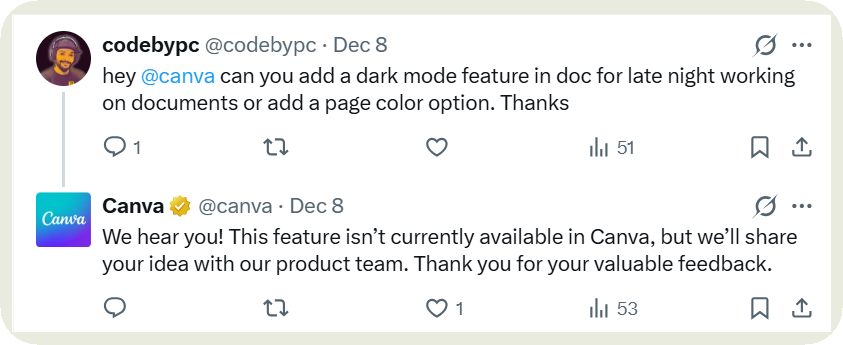
Best practices for refining product development
- Build a ‘social-to-product’ feedback loop. Share weekly or monthly social insights with product, engineering, and design teams so they can prioritize what users actually want.
- Use polls and Q&A features intentionally. Ask users what feature they want next, what frustrates them most, or how they use your product. Treat it as rapid, real-time user research.
- Monitor competitor complaints. Customers often highlight what other tools lack. These gaps can become your next opportunities.
- Validate new ideas publicly. Tease a potential feature, drop a mockup, or ask for input on early concepts. You’ll instantly see what excites your audience.
- Identify unexpected use cases. Watch how people creatively use your product on social. These insights often spark new features, templates, or workflows you never considered.
- Highlight user stories. Showcase examples of customers who benefit from new updates. It reinforces product credibility and shows you’re listening.
Final thoughts
Social media for companies can influence how people discover you, trust you, buy from you, and stay with you long after the first click. Instead of treating it like a side task, start using it as a real growth engine.
You will get clearer insights, stronger communities, better talent, and smarter marketing.
So listen to what your audience is telling you. Lean into the content that sparks conversations. Turn happy customers into your loudest advocates. And use every interaction as a clue for what to build or improve next.
If you need help with social media analytics to see the results it is generating for you, try Socialinsider for free for 14 days.
FAQs on social media's impact on business
1. How social media impacts marketing for small businesses?
Social media in marketing helps small businesses market smarter by giving them low-cost visibility, direct access to their audience, and real-time insights into what customers want. It boosts brand awareness, drives website traffic, and creates opportunities to showcase products through UGC, reviews, and storytelling. With the right content and consistency, small businesses can compete with larger brands and convert followers into buyers.
2. How businesses use social media for marketing?
Businesses use social media to reach new audiences, build brand awareness, and nurture customer relationships. They share content that educates or entertains, run targeted ads, promote products, and drive traffic to their websites. Social platforms also help them gather customer feedback, track trends, and refine their messaging.
3. Why is social media important for business?
The importance of social media for business is high because it helps your business get discovered, build trust, and connect directly with customers at scale. It drives brand awareness, website traffic, and sales while giving real-time insights into what people want. It also strengthens customer support, fuels recruiting, and creates communities that keep buyers loyal.
Analyze your competitors in seconds
Track & analyze your competitors and get top social media metrics and more!
You might also like
Improve your social media strategy with Socialinsider!
Use in-depth data to measure your social accounts’ performance, analyze competitors, and gain insights to improve your strategy.


